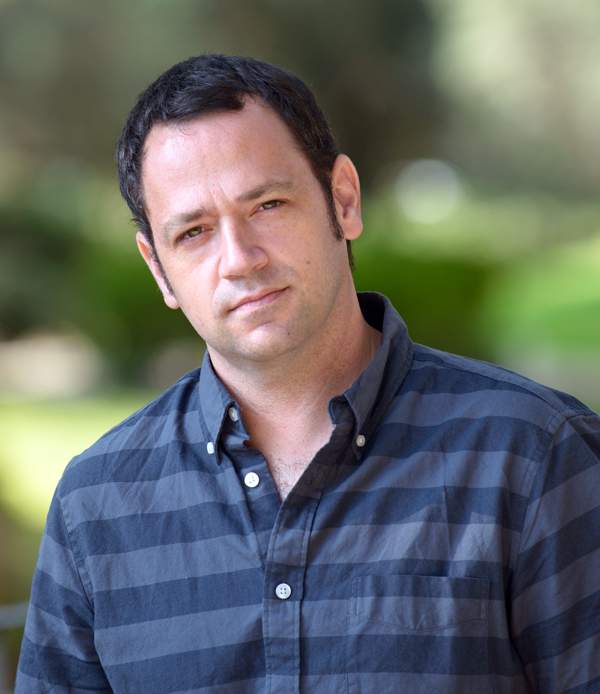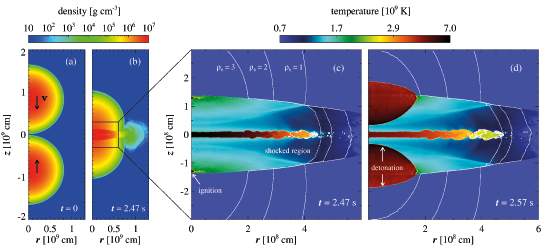Are you a journalist? Please sign up here for our press releases
Subscribe to our monthly newsletter:

A threesome is a potentially explosive arrangement. That may be as true for the stars as it is for people: Dr. Boaz Katz believes that a three-body model could explain many of the huge stellar explosions known as supernovae. In this model, which he and his colleagues Drs. Subo Dong and Doron Kushnir developed during his postdoctoral research at the Institute for Advanced Study, Princeton, the disruptive third star sends its two companions hurtling into one another for a head-on collision. Katz hopes to uncover more evidence for this model of supernova formation through research with his new group in the Weizmann Institute’s Particle Physics and Astrophysics Department.
Katz says he and Dong came to the idea while studying something entirely different: exoplanets. In the last decade, astronomers have detected thousands of planets orbiting stars outside of our solar system; a few of these make up solar systems much wilder than ours. Rather than swinging around their sun in orderly circular paths, all in the same plane; these distant planets have been recorded circling in unstable, elongated orbits in planes that lie at skewed angles to one another. Katz and Dong were investigating the origins of this disorderly behavior, especially theories that these behaviors arise from the gravitational effects of other planets or a companion star in the system.
These wild orbits often put stars and their planets on collision courses, and Katz and Dong began to wonder whether stars might similarly collide – and what might happen if they did. Could certain stars, in certain circumstances, run into one another head-on with enough energy to ignite the nuclear dynamos at their cores?
Katz and Dong then approached Doron Kushnir, who was also at the Institute for Advanced Study. Kushnir had been working on fundamental questions concerning the explosion mechanisms of supernovae, and he was one of only a few scientists in the world who had the tools to calculate whether such collisions would actually end in giant blasts.
Most observed supernovae are of the type known as 1a, and the fact that these all look alike suggests they occur in a similar way. Astrophysicists generally agree that the stars that explode to become type 1a supernova are white dwarfs – old stars that are about the circumference of the Earth and the mass of the sun, making them a million times denser than water or the Sun. It was thought, however, that white dwarfs blow up only when they become “overweight,” either from vacuuming up material from a larger companion or merging with another white dwarf. These scenarios turn out to be very difficult to analyze, and neither one has been demonstrated to lead, incontrovertibly, to an explosion. Katz and his colleagues think that the weight limit is something of a red herring; they propose that the explosion is caused by a direct collision between two white dwarfs. The calculations, at least, bear out this idea. Like the exoplanets careening in wild orbits, these two would need a third companion star to create instability in their relationship.

Three-body problems are common in physics. And the three-body computations that Katz and Dong performed indeed revealed a subset of triple star systems that would be likely to end in head-on collision – if two white dwarfs circled one another closely and the third star orbited them at a distant, oblique angle to their plane. In this scenario, once the two white dwarfs are prodded by the third star into the right place, gravity takes over and they speed toward one another at thousands of kilometers a second. Kushnir’s calculations clearly demonstrated that this crash is powerful enough to ignite a runaway nuclear reaction in both stars.
Could this be the explanation for type 1a supernovae?
The model, says Katz, appears to be in the right ballpark, but it will require much more observation and analysis to see if it stands. Such observations of nearby stars are now being conducted and analyzed, but these are tricky. White dwarfs are not easy to see, especially when they are close to a brighter star. We haven’t even reliably mapped out the white dwarfs in the nearest solar neighborhood. In the meantime, Katz and his colleagues have begun to predict some of the things that might be seen if this model is correct. Indeed, they have found that some of the existing data collected on type 1a supernovae seems to fit the model’s predictions, including, for example, two “bumps” in the spectra of the material thrown outward that hint at the possible remnants of two separate iron cores.
In his Weizmann Institute group, he and his research students Nahliel Wygoda and Ygal Klein will, among other things, continue searching for patterns in the data that could lend credence to the head-on-collision model.
Katz: “We think this is the true explanation for type 1a supernovae. Direct collision is the only known mechanism that has been reliably demonstrated to lead to an explosion.”
Dr. Boaz Katz was born in Haifa and grew up on a moshav in the Galilee region. His interest in physics, he says, was fired by his participation in high school in the Physics Olympics, both in Israel, where he won first place, and in the International Physics Olympics, where he won a bronze medal.
At the Weizmann Institute, he completed a master’s degree in theoretical physics, studying string theory in the groups of Profs. Micha Berkooz and Ofer Aharony. But a course in astrophysics taught by Profs. Eli Waxman and Yosef Nir piqued his interest, and he continued his doctoral studies in Waxman’s group.
After four years at the Institute for Advanced Study as a long-term member, Katz joined the Weizmann Institute in 2015. Among other things, he is teaching a course in astrophysics to new students, and he hopes to inspire them, as he was inspired, to continue researching the workings of the Universe.
Katz is married to Liz, a CPA, and is the father of three sons, aged 9, 6 and 2.
Dr. Boaz Katz’s research is supported by the Abraham and Sonia Rochlin Foundation. Dr. Katz is the incumbent of the Beracha Foundation Career Development Chair.